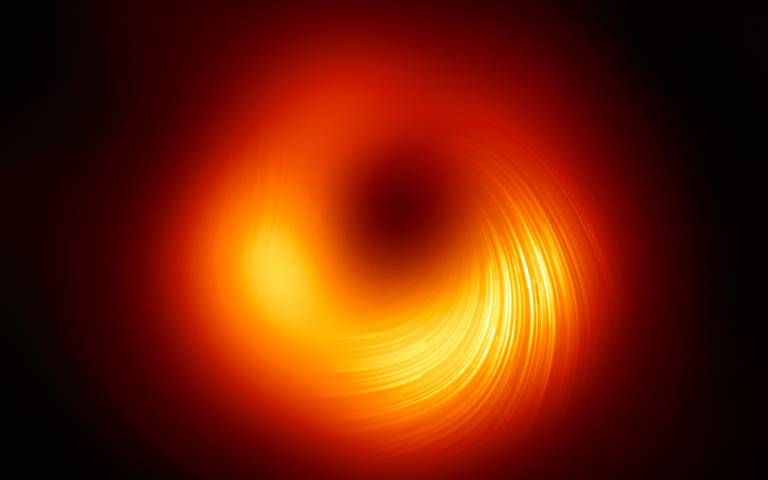New image reveals magnetic fields at black hole’s edge
24 March 2021
A new image of the supermassive M87 black hole has been unveiled by the Event Horizon Telescope (EHT) collaboration involving UCL researchers, giving a closer look at how the black hole interacts with the matter surrounding it.

The EHT team released the first image of a black hole in 2019, revealing a bright ring-like structure with a dark central region described as the black hole’s shadow.
The new observations, described in two papers in The Astrophysical Journal Letters, provide insights into the region just outside the black hole, where some matter is falling in, while other matter is being blown into space in the form of bright, powerful jets that extend at least 5,000 light years away, beyond the galaxy in which the black hole resides.
Using the same data as for their first image, the collaboration analysed polarised light around the black hole – that is, light whose waves are vibrating in one direction only. The light becomes polarised when it is emitted in hot regions of space that are magnetised. By looking at how it has become polarised, astronomers can learn about the material that produced it.
Researchers say their new evidence brings us a step closer to understanding how these mysterious jets are produced, and how magnetic fields appear to act to keep hot gas out of the black hole, helping it resist gravity’s pull.
Co-author and EHT collaboration member Dr Ziri Younsi (UCL Mullard Space Science Laboratory, MSSL) said: “These ground-breaking measurements of the polarisation of light produced at the edge of the black hole’s event horizon provide us with exciting new insights into the physical processes by which black holes feed on matter, and how they are able to power such prodigious relativistic outflows as astrophysical jets. In particular, they hint at the role played by magnetic fields in these processes.”
Dr Jason Dexter, of the University of Colorado, Boulder, US, said: “The observations suggest that the magnetic fields at the black hole’s edge are strong enough to push back on the hot gas and help it resist gravity’s pull. Only the gas that slips through the field can spiral inwards to the event horizon.”
The EHT is an international collaboration set up to image a black hole by linking eight ground-based radio telescopes globally to make an Earth-sized virtual telescope with unprecedented sensitivity and resolution – a resolution sharp enough to measure an orange on the Moon from Earth.
The black hole that the collaboration has imaged is located in a galaxy called Messier 87, or M87, and is 55 million light years away. It has a mass 6.5 billion times that of the Sun.
Astronomers have relied on different models of how matter behaves near the black hole to better understand this process. But they still do not know exactly how jets larger than the galaxy are launched from its central region, which is as small in size as the Solar System, nor how exactly matter falls into the black hole.
The observations provide new information about the structure of the magnetic fields just outside the black hole. The team found that only theoretical models featuring strongly magnetised gas can explain what they are seeing at the event horizon.
Co-author Dr Monika Mościbrodzka, of Radboud University in the Netherlands, said: “We are now seeing the next crucial piece of evidence to understand how magnetic fields behave around black holes, and how activity in this very compact region of space can drive powerful jets that extend far beyond the galaxy.”
Co-author Dr Iván Martí-Vidal, at the University of Valencia, Spain, said: “This work is a major milestone: the polarisation of light carries information that allows us to better understand the physics behind the image we saw in April 2019, which was not possible before.” He added that “unveiling this new polarised-light image required years of work due to the complex techniques involved in obtaining and analysing the data”.
The observations were made in 2017 using a technique called very-long-baseline interferometry which synchronises telescopes around the world and exploits Earth’s rotation to form one planet-sized telescope.
The telescopes are located in volcanoes in Hawai’i and Mexico, mountains in Arizona and in the Spanish Sierra Nevada, the Chilean Atacama Desert, and Antarctica.
Links
- Paper VII in The Astrophysical Journal Letters
- Paper VIII in The Astrophysical Journal Letters
- Dr Ziri Younsi’s academic profile
- Mullard Space Science Laboratory at UCL
- UCL Mathematical & Physical Sciences
- The EHT collaboration
- The EHT release
- Video: The M87 image as seen through a light polarizer
- Video: What Is Polarization
- Video: Magnetic fields and black hole images
- Animated image: Transition between the observed polarization image and a best-fit theory image
Image
A view of the M87 supermassive black hole in polarised light. The lines mark the orientation of polarisation, which is related to the magnetic field around the shadow of the black hole. Credit: EHT Collaboration
Media contact
Mark Greaves
T: +44 (0)7990 675947
E: m.greaves [at] ucl.ac.uk
 Close
Close

